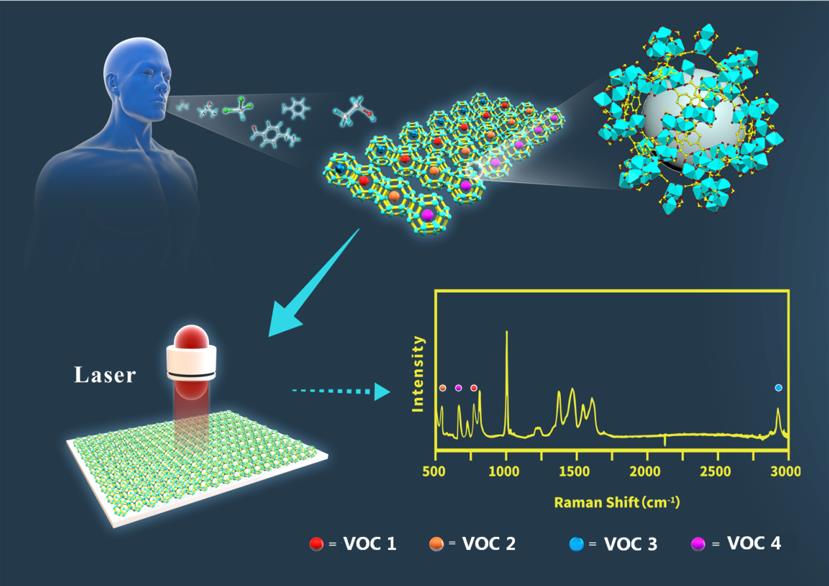Breakthrough in Multiplex Detection of VOCs Based on SERS-Active MIL-100(Fe) Sensory Array
A typical metal-organic framework, MIL-100(Fe), was demonstrated for the first time to function as an excellent surface-enhanced Raman scattering (SERS)-active substrate for high sensitivity detection of diverse VOCs by Assoc. Prof. Min Li's group from the Institute of High Energy Physics and by Prof. Zhenxia Zhao's group from Guangxi University. The study, entitled "SERS-Active MIL-100(Fe) Sensory Array for Ultrasensitive and Multiplex Detection of VOCs," was recently published in Angewandte Chemie International Edition.
This contribution details an original and important application of metal-organic frameworks (MOFs), as novel SERS substrates, in the multiplex sensing of trace concentrations of VOCs that usually possess low Raman cross-sections and are hard to detect.
Volatile organic compounds (VOCs) are mostly toxic and even carcinogenic. However, human olfactory systems are usually not sensitive enough to discern these volatile dangers. Conventional gas sensing devices generally suffer from problems such as small sensing area and low detection sensitivity. Therefore, developing a sensing platform for effective and sensitive detection of VOCs is of great significance and has received extensive attention.
This research reveals that MIL-100(Fe) composed of Fe clusters and 1,3,5-benzenetricarboxylic acid (TMA) can serve as an ideal SERS-active substrate for the capture and recognition of diverse VOCs. Raman enhancement up to 1010 and 0.48 ppb VOC detection has been accomplished by depositing concentrated gold nanoparticle colloid onto the MIL-100(Fe) substrate, thus forming SERS "hot spots." The results of special adsorption energy and DFT calculations show that energy-level structures account for the high SERS activity when MIL-100(Fe) is used as a substrate in VOC detection, suggesting the CT enhancement mechanism during the sensing process (Fig. 1). The unique structural character of MOFs, that is, their aromatic ligand structure and metal active sites, makes MIL-100(Fe) a unique "array sensor" for multiplex VOCs, offering high sensitivity (Fig. 2). Remarkably, when doping MIL-100(Fe) with foreign metal elements (eg., Zr) to create different "active binding sites," the as-modified MIL-100(Fe-Zr) selectively improved the sensing performance of the platform in recognizing certain VOCs (in this case, isopropanol), suggesting the great modifiability and expandability of MIL-100(Fe) as an array sensor for multiplex sensing. We finally applied the MIL-100(Fe) sensing platform to the detection of gaseous indicators of lung cancer, including 4-ethylbenzaldehyde, isopropanol and acetone with a ppm detection limit, demonstrating its high potential for early diagnosis of lung cancer in vivo.
This study further expands the scope of materials for use as SERS substrates beyond noble metals and semiconductors, thus potentially broadening the application of Raman in a wide range of areas. These findings shed light on potential applications of MOF materials in the area of artificial olfactory systems for multiplex VOC detection, which is of great significance in industrial safety, environmental monitoring and even clinical applications.

Fig. 1 SERS spectra of multiplex sensing of diverse VOCs using MIL-100(Fe) platform, and the energy-level diagrams of VOCs and MIL-100(Fe) with respect to vacuum level

Fig. 2 Schematic diagram of the unique "sensory array" character of MIL-100(Fe) for multiplex VOCs detection with high sensitivity
Article Information: Jing-Hao Fu, Zhen Zhong, Dan Xie, Yan-Jun Guo, De-Xuan Kong, Zhong-Xing Zhao, Zhen-Xia Zhao*, Min Li*. “SERS-Active MIL-100(Fe) Sensory Array for Ultrasensitive and Multiplex Detection of VOCs”, Angew. Chem. Int. Ed., 2020, DOI: 10.1002/anie.202002720
Contact Information
Mr. Guo Lijun
ljguo@ihep.ac.cn